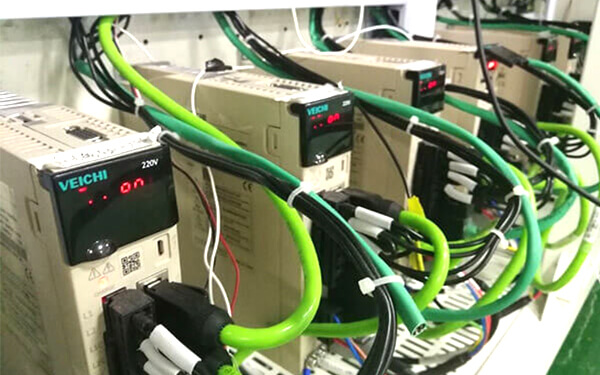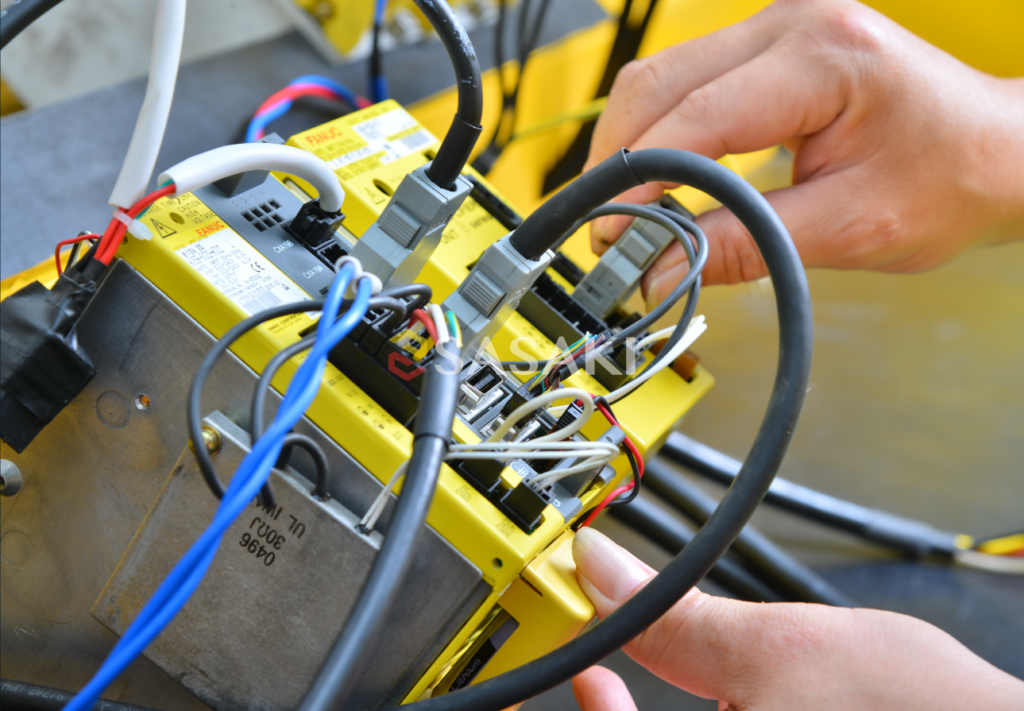Servo Alarms Causes and Solutions
Servo systems are integral to many modern automation and control applications, providing precise motion control in industries such as robotics, manufacturing, and aerospace. However, servo alarms can disrupt operations and cause significant downtime if not addressed promptly. This guide will explore common causes of servo alarms and provide practical solutions to mitigate them, ensuring smoother and more reliable operations.
Identify the Servo Alarms
1.1 Alarm Indicator
- Visual Inspection: Check the servo drive’s display panel or LED indicators for any alarm indications.
- Software Interface: If available, use the servo drive configuration software to check for alarm codes or messages.
1.2 Alarm Code Interpretation
- Reference Manual: Consult the servo drive’s user manual or documentation to decode the alarm code.
- Online Resources: Manufacturers often provide online resources or forums where users can find information about specific alarm codes.

Understand the Servo Alarms
2.1 Alarm Type
- Identify Alarm Type: Determine the type of alarm (e.g., overcurrent, overtemperature, communication error) based on the code and description.
- Severity: Assess the severity of the alarm and its potential impact on system operation and safety.
2.2 Potential Causes
- Review Manual: Refer to the manual or documentation to understand potential causes associated with the alarm type.
- System Inspection: Inspect the servo system components, including motors, drives, cables, and connections, for any visible signs of issues or damage.

Common Causes of Servo Alarms
1. Overcurrent Alarm
Cause: Excessive current flow through the servo motor, often due to mechanical overload, short circuits, or abrupt starts and stops.
Solution:
- Inspect for mechanical obstructions.
- Check wiring for shorts or damage.
- Adjust acceleration and deceleration parameters.
2. Overload Alarm
Cause: The servo motor operates beyond its rated capacity, usually due to sustained heavy loads.
Solution:
- Reduce the load on the motor.
- Ensure proper motor sizing for the application.
- Allow cooling periods for the motor.
3. Overvoltage Alarm
Cause: Voltage supplied to the servo drive exceeds the maximum allowable limit, often due to regenerative energy from decelerating motors.
Solution:
- Install a braking resistor to dissipate excess energy.
- Check the power supply for voltage spikes.
- Adjust deceleration settings.
4. Undervoltage Alarm
Cause: Insufficient voltage supply to the servo drive, possibly due to power supply issues or loose connections.
Solution:
- Ensure stable power supply voltage.
- Tighten all electrical connections.
- Replace faulty power supply components.
5. Encoder Fault Alarm
Cause: Issues with the encoder signals, often due to misalignment, wiring issues, or encoder damage.
Solution:
- Realign or replace the encoder.
- Check and secure encoder wiring.
- Clean encoder components to remove any debris.
6. Overtemperature Alarm
Cause: The servo motor or drive exceeds its temperature limits, typically due to poor ventilation or excessive load.
Solution:
- Improve ventilation and cooling.
- Reduce motor load.
- Regularly maintain and clean cooling systems.
7. Communication Error Alarm
Cause: Faulty communication between the servo drive and controller, usually due to wiring issues or software faults.
Solution:
- Check and secure communication cables.
- Update or reinstall controller software.
- Ensure proper configuration of communication settings.
8. Position Error Alarm
Cause: The motor’s actual position deviates significantly from the commanded position, often due to mechanical slippage or encoder issues.
Solution:
- Check Mechanical Connections: Ensure all connections and couplings are secure.
- Inspect Encoder: Verify that the encoder is functioning correctly.
- Recalibrate System: Perform system calibration to align actual and commanded positions.
9. Speed Error Alarm
Cause: The motor’s speed exceeds its permissible range, often due to incorrect parameter settings or mechanical issues.
Solution:
- Adjust Speed Parameters: Fine-tune the speed settings in the servo drive.
- Inspect for Mechanical Issues: Check for obstructions or wear that might affect speed.
- Monitor Load: Ensure the load is within the motor’s capacity.
10. Feedback Loss Alarm
Cause: Loss of feedback signals from the encoder or resolver, often due to wiring issues or sensor faults.
Solution:
- Check Feedback Wiring: Inspect and secure all feedback signal wiring.
- Replace Faulty Sensors: Swap out any malfunctioning encoders or resolvers.
- Ensure Proper Shielding: Use shielded cables to prevent signal interference.
11. Ground Fault Alarm
Cause: A ground fault indicates a direct or indirect connection between the system’s electrical circuits and the ground, which can lead to malfunction.
Solution:
- Inspect Insulation: Check the motor and wiring insulation for wear or damage.
- Test Ground Connections: Use a multimeter to test for unintended ground connections.
- Repair or Replace: Fix or replace damaged components to restore proper insulation.
12. Contamination Alarm
Cause: Presence of dust, moisture, or other contaminants within the servo motor or drive, which can interfere with operation.
Solution:
- Clean Components: Regularly clean the motor and drive components to remove contaminants.
- Improve Sealing: Enhance the sealing of enclosures to prevent contamination.
- Maintain Environment: Ensure the operating environment is clean and dry.
13. Phase Loss Alarm
Cause: Loss of one or more phases in the power supply, which can disrupt the motor’s operation.
Solution:
- Check Power Supply: Inspect the power supply for phase loss.
- Secure Connections: Ensure all phase connections are secure and intact.
- Replace Faulty Components: Replace any damaged or malfunctioning power supply parts.
14. Excessive Vibration Alarm
Cause: Excessive mechanical vibration can damage the motor and interfere with accurate operation.
Solution:
- Balance the Motor: Ensure the motor and connected components are properly balanced.
- Inspect Bearings: Check bearings for wear and replace if necessary.
- Secure Mounting: Ensure the motor is securely mounted to reduce vibration.
15. Brake Failure Alarm
Cause: Failure of the motor’s braking system, which can lead to uncontrolled movement.
Solution:
- Test Braking System: Regularly test the braking system for functionality.
- Replace Worn Parts: Replace any worn or damaged braking components.
- Adjust Brake Settings: Fine-tune the brake settings to ensure proper operation.
Responding to Servo Alarms:
- Alarm Display: When a servo alarm occurs, the drive typically displays an alphanumeric code or LED indicator to identify the specific fault.
- Referencing Manual: Consult the servo drive manual or documentation to interpret the alarm code and identify potential causes.
- Troubleshooting: Perform diagnostic checks to identify and resolve the underlying issue. This may involve inspecting connections, checking motor operation, adjusting parameters, or contacting technical support.
- Resetting Alarms: Once the underlying issue is resolved, reset the servo alarm through the drive’s interface or control software. Ensure the system is operating normally before resuming production.
Practical Troubleshooting Servo Alarms
- Identify the Alarm Code: Refer to the servo drive or controller manual to understand the specific alarm code and its meaning.
- Inspect Physical Components: Check for visible damage or issues with the motor, wiring, and connectors.
- Review System Parameters: Verify and adjust system settings such as load limits, acceleration, and deceleration parameters.
- Test Individual Components: Isolate and test components such as encoders, power supplies, and communication modules.
- Consult Technical Support: Contact the servo motor manufacturer or technical support for advanced troubleshooting and assistance.
Preventative Measures of Servo Alarms
- Regular Maintenance: Conduct routine inspections and maintenance of the servo motor system.
- Proper Sizing and Configuration: Ensure motors and drives are correctly sized and configured for the application.
- Environmental Controls: Maintain optimal environmental conditions, including temperature and humidity, to prevent overheating and condensation.
- Training and Documentation: Train personnel on the operation and maintenance of servo systems and maintain comprehensive documentation for troubleshooting.
Conclusion of Servo Alarms
Servo alarms are crucial for detecting and addressing issues in motion control systems. By understanding the common causes and implementing effective solutions, you can ensure the reliability and efficiency of your machinery. Regular maintenance and proper system configuration are key to preventing these alarms and maintaining smooth operations.
FAQs
- What should I do if a servo alarm persists despite troubleshooting?
- If the alarm persists, consult the servo system’s manual or contact the manufacturer’s technical support for further assistance.
- Can servo alarms indicate multiple issues simultaneously?
- Yes, some alarms may indicate multiple underlying issues. Thorough diagnostics are necessary to identify and resolve all contributing factors.
- How often should I perform maintenance on my servo system?
- Regular maintenance should be performed as per the manufacturer’s recommendations, typically every few months or based on operational hours.

